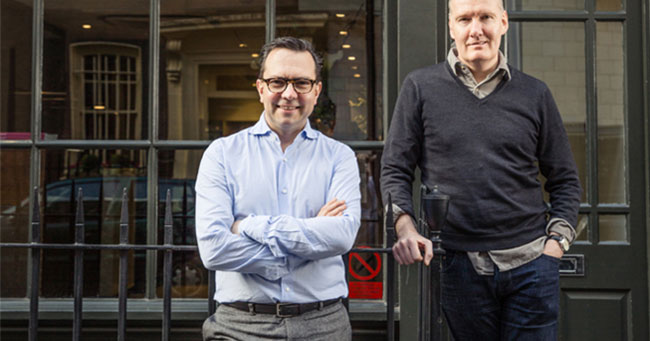Destination dining: are the days of having your name above the door numbered?
For many chefs, the holy grail is their own Michelin-starred landmark restaurant, but the route to commercial and critical success has been broadening exponentially. In an increasingly casual and dynamic restaurant scene, Andy Lynes asks whether creating an iconic destination site should still be the dream
They've been dropping like flies. First James Durrant closed the Plough Inn in Longparish, Hampshire, in December 2015, then Tom van Zeller shut his eponymous Harrogate restaurant in July 2016 after seven years of trading, blaming Brexit. Arbutus in Soho served up its final meal soon after, with business partners Anthony Demetre and Will Smith parting ways after 20 years of collaboration on various London ventures.
Claude Bosi handed in the keys to Mayfair landmark Hibiscus in October that year and has since gone into partnership with Sir Terence Conran at Bibendum, while Ollie Dabbous closed his flagship restaurant earlier this year. Meanwhile, casual, buzzy modern restaurants, such as Smoking Goat, Kiln, Som Saa and Hoppers have become some of the hottest tables in town.
Aspiring to Michelin stars is definitely something that has been consigned to the past for van Zeller, who trained with Raymond Blanc, Tom Aikens and Pierre Koffmann. "I have no desire to go back into the restaurant industry because, in my view, it's changed," he explains. "I am considering perhaps doing a pop-up because of the limited resources I'd need regarding capex and ongoing overheads, which can be very difficult in a saturated market dominated by corporate chains with no real skill base but with more expensive branding.
"I closed Van Zeller because I ran out of money. I formed the company in October 2008 and opened on Friday 13 February 2009. In those five months the FTSE 100 dropped below 4,000 points, and that financial uncertainty followed me throughout the journey of my business. To then have Brexit come along and for financial uncertainty to raise its head again had me worried. I didn't want to continue to struggle financially."

Dislocation, dislocation, dislocation
Location was a major factor in Durrant deciding to close the Plough Inn and take the position of executive chef of the Game Bird at London's Stafford Hotel.
"Within the first three months it dawned on me that we'd picked the wrong village," says Durrant of Longparish in Hampshire. "I was fortunate enough to get on TV, and yet we could only fill it every weekend. We tweaked the food, improved our service level, but, along with that, staff costs rose as we got more chefs and waiters. After three and half years, it was continuing to make only a small profit."
The reason given in a press statement by owners Dabbous and Oskar Kinberg for this summer's closure of Michelin-starred Dabbous, which opened to universal critical praise in 2012, was that "a major undertaking set to launch in late 2017/early 2018 would require the entire team, complemented by additional members of staff to concentrate all their efforts on this ground-breaking new venue".
Peter Harden of Harden's restaurant guide believes there's a more straightforward explanation: "Because I do an annual survey, I'm particularly sensitive to the mismatch there often is between the celebrity of chefs and how well their restaurants are actually doing," he says. "Ollie Dabbous ran a restaurant that was exceptional when he opened it, but was really rather mediocre when he decided to close it - he'd over-extended himself quite a lot."
It's unusual for a lauded chef to close an established flagship restaurant to open another one rather than expanding, but it seems that Dabbous is in the process of reinventing himself - at least according to the press release, which states: "The restaurant will have a completely different identity to that of Dabbous."
The chef has also swapped gourmet dude food at the short-lived BarnYard for more than a hint of "wellness" at the Henrietta Hotel, where he oversees a menu punctuated by edible flowers, foraged herbs and grains. It's a radically different
career path from that of his mentor, Blanc, who has spent more than three decades evolving and refining his core business, Belmond Le Manoir aux Quat'Saisons.
There's more than a whiff of bandwagon jumping about it, but the move could be one that more top chefs follow.
"I think that may well be a sensible thing to do because we're seeing a change in taste quicker than ever," says Peter Martin, vice-president of data and research consultancy CGA. "In the eating-out sector, it's all about market share gain at the moment. It's fairly stable, which is good news, but there are still new entrants, so the competition is fierce, and people have the opportunity to go and try something new all the time; unless you really establish yourself, it's tricky. We've seen it in casual dining that the more established brands fall out of favour pretty quickly because there's something new coming along, and the same would apply to the top end. Unless you are a Jason Atherton with an established reputation, it's going to be tough."
Nevertheless, that fierce competition for market share has opened up a wealth of opportunities not available to previous generations.
"Back then, you'd have to save up or find an angel investor," says Harden. "Now someone who's got half an idea can start out from the back of a truck, achieve a reputation using social media, and know that if they get any traction at all there's venture capital prepared to plug in huge pipes of money to make that idea grow and scale internationally in a way you never could going back all those years."
Neil Rankin, who has a background in fine dining, having trained with Gary Rhodes and Michael Wignall, is one of the beneficiaries of this new money. He has opened two branches of his barbecue concept Temper in London within nine months, backed by leisure and hospitality investment fund Imbiba.
"I don't think I've ever done the big accolade thing. I never really aspired to do it. I'm more of a casual dining guy," says Rankin, who is already looking at further sites for Temper.
"There's too much focus sometimes on chefs' techniques. Sometimes they add to the experience, but a lot of times they don't. There are some seriously good chefs, like Sat Bains and Tom Kerridge, and they can pull it off, but for your average restaurant in London, it's not what people go out for."
Fickle foodies
The modern marketplace is increasingly influenced by the habits of millennials (a recent survey showed that spend on eating out is rising among 18- to 34-year-olds and falling among 35- to 54-year-olds), who, according to research, are less brand-loyal than their parents. What they want from a night out may not necessarily line up with what a traditional iconic destination restaurant delivers.
"We're much more inclined to think carefully about what our younger guests want," says restaurant consultant Mike Palmer, who co-owns Pike & Pine in Brighton with chef Matt Gillan. "When we wrote the positioning for Pike & Pine, it was about new luxury and what that means - it definitely didn't mean chandeliers and bow ties, because you can get that everywhere. We decided it was health, wellness, connection to nature, space, privacy - what you can't get if you live in a box in a city."
But with the number of restaurants opening at breakneck speed, and the fickle diner trotting from one to the other, can restaurateurs hope to create the sort of loyal customer base a destination restaurant often needs?
"You need those social butterflies and early adopters to help you spread the message," says Palmer. "But it raises the question: while you're flavour of the month, what are you doing for your loyal followers in the knowledge that they aren't going to be loyal forever?
Unless you make some effort to reach out to them and try and get them to invest emotionally in your business, create interest and reasons to revisit, you're in the shit."
There is therefore a need to innovate and at pace like never before, and that's not necessarily the strong suit of iconic restaurants where consistency is key in attracting the sort of guide book approbation that helps make their reputation.
For the second branch of Temper, for example, Rankin has given the menu a different emphasis with a range of curries and tandoor-roasted meats to enhance the barbecue concept of the original branch.
"We constantly innovate the menu," Rankin says. "Customers want new things, they want changes and specials, to come back and be excited by a new dish. For the staff, just to do the same thing every day is fine if you're trying to hit three Michelin stars, but if not that it's nice to change what your working day is and have a bit more fun."
Menu content isn't the only thing that has to be constantly updated to appeal to the millennial audience - format is crucial, too.
"I'm seeing fewer tasting menus and much more choice," says Palmer. "There's still expensive restaurants that do fantastic food, but you're more involved and engaged, the whole thing is a little more experiential. At Pao in Miami, for example, you pay for your bites separately, and then you have small plates, and
then you have large plates that you can share, possibly in a more millennial way because you get total choice over your menu."
Cost conscious
But according to Bruce Poole, chef-proprietor of over 20 years' standing with three Michelin-starred London restaurants (Chez Bruce, the Glasshouse and La Trompette), it won't just be customers who decide the future of iconic restaurants: "The overheads involved in running these kinds of restaurants are so significant, with rents going up - that this is going to be the driver, not necessarily what customers want. If you've got a certain square footage, you've got to get a certain number of customers in there and a certain number of sales per week.
If your smart, Michelin-starred, chef-led restaurant can't do the covers, it's not going to work."
Twenty-five years ago, chefs were likely to open their own restaurants in the image of their mentors, basing their own operations on places where they had worked long hours over many years, and were accordingly a perpetuation of the sort of places that might attract accolades. Now, with cheaper international travel and social media, the inspiration for a restaurant concept can come from anywhere.
With money pouring into large developments such as Nova in Victoria, the Bloomberg building in the City, and Battersea Power Station, which all focus on good-quality middle market eateries - such as Atherton's Hai Cenato (Nova) and Francesco Mazzei's Fiume (Battersea), does that mean chefs such as Tom Sellers at Restaurant Story, who still put stock in fine dining, are swimming against a tide that will inevitably wash them away?









